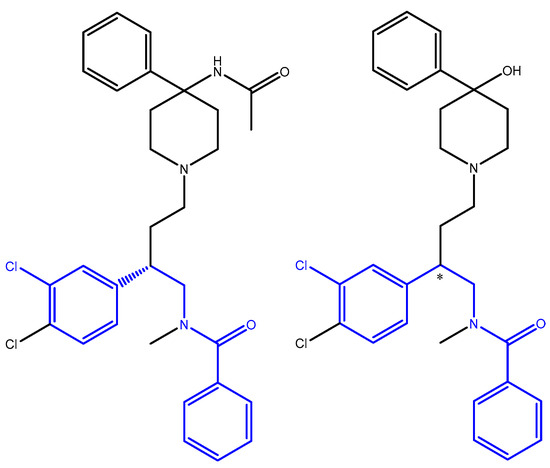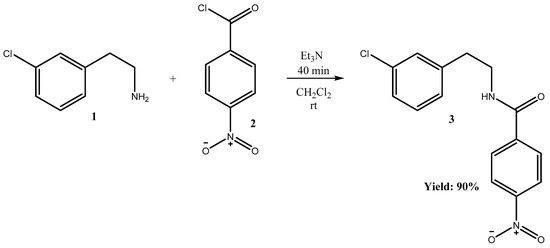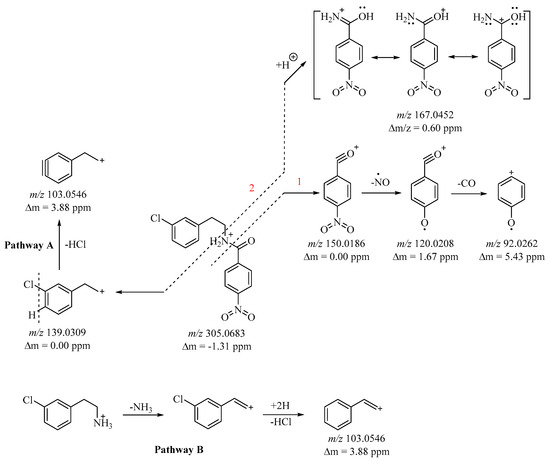Abstract
Herein, we report the synthesis of N-(3-chlorophenethyl)-4-nitrobenzamide in the reaction between 2-(3-chlorophenyl)ethan-1-amine and 4-nitrobenzoyl chloride. The newly obtained bio-functional hybrid molecule was fully characterized via 1H, 13C NMR, UV, and mass spectral data.
1. Introduction
2-Phenylethylamine (PEA), holds significant importance in the realm of neuroscience and pharmacology [1]. As a naturally occurring compound in the human body, PEA acts as a neuromodulator, influencing mood, cognition, and behavior. Its role extends to the regulation of neurotransmitter levels, particularly dopamine and norepinephrine, contributing to feelings of euphoria and alertness. Beyond its endogenous functions, PEA also serves as a precursor to various neurotransmitters, and plays a vital role in the synthesis of catecholamines [2]. Moreover, PEA’s pharmacological properties have garnered attention in drug discovery, with researchers exploring its potential therapeutic applications, including in the treatment of mood disorders and attention deficit hyperactivity disorder (ADHD) [3]. Thus, 2-phenylethylamine stands as a molecule of considerable importance, both in understanding neural functions and as a target for therapeutic intervention.
Chlorine atoms have a proven, important role in various natural products [4]. Through empirical observation, researchers have noted that strategically incorporating chlorine into specific positions of biologically active molecules can notably enhance their inherent biological activity [5].
In addition, the nitro group represents a versatile and valuable functional group in drug design, contributing to a wide range of therapeutic agents with applications in antimicrobial therapy, cancer treatment, and beyond. Its diverse pharmacological effects make it a compelling target for further exploration and innovation in medicinal chemistry [6].
Linking 2-phenylethan-1-amine and 4-nitrobenzoyl chloride is crucial for their joint application in organic synthesis and pharmaceutical development. The former contributes a versatile building block, while the latter enhances bioactivity with its nitro group. This connection facilitates the synthesis of hybrid materials, crucial in medicinal chemistry. Understanding the mutagenic risks of nitroarenes is vital in drug design, underscoring the importance of connecting these compounds for comprehensive pharmaceutical development.
Potent neurokinin-2 antagonists, like SR 48,968 and racemic 4-hydroxy-4-phenyl-piperidine derivative of SR 48,968 (Figure 1), own the structure of N-(3-chlorophenethyl) -4-nitrobenzamide without the nitro group [7].

Figure 1.
Highly effective neurokinin-2 antagonists include: SR 48,968 and its racemic 4-hydroxy-4-phenyl piperidine derivative.
Compounds sharing a similar structure are of great interest to the scientific community, due to their utility as convenient intermediates for synthesizing diverse cyclic compounds [8,9]. Moreover, other compounds exhibiting a similar structure demonstrate antitumor [10] and neurotropic [11] activities, among others.
2. Results and Discussion
Here, we present the successful synthesis of N-(3-chlorophenethyl)-4-nitrobenzamide 3, as illustrated in Scheme 1. To achieve this, 4-nitrobenzoyl chloride 2 (1 mmol) was introduced into a solution of 2-(3-chlorophenyl)ethan-1-amine 1 (1 mmol) in dichloromethane. The resulting mixture was stirred for ten minutes, followed by the careful addition of an excess of trimethylamine (1.5 mmol). Within 30 min, TLC analysis confirmed the formation of the desired product 3. This reaction, known as the Schotten–Baumann reaction, provides a facile and rapid method for synthesizing amide bonds from amines and acyl chlorides.

Scheme 1.
Synthesis of N-(3-chlorophenethyl)-4-nitrobenzamide 3.
The novelty of molecule 3 is confirmed through the Reaxys online platform, establishing it as a new compound. Extensive characterization, including determination of its melting point and analysis using 1H-, 13C-NMR, UV spectroscopy, and detailed mass spectral analysis, is conducted to thoroughly understand its properties. Additionally, the fragmentation of this unique amide molecule 3 is observed through cleavage of the amide bond.
The amide molecule 3 undergoes fragmentation through two pathways: one involves cleaving the amide bond (pathway 1), while the other pathway involves breaking the sigma bond between the amide bond and the αC-atom (pathway 2), as illustrated in Figure 2. These pathways result in the formation of characteristic ions representing the nitrophenylacyl fragment. For instance, pathway 1 yields the (4-nitrobenzylidyne)oxonium cation with m/z 150, while pathway 2 produces the 4-nitrobenzamidic cation with m/z 167. Furthermore, pathway 2 yielded the 2-(3-chlorophenyl)ethan-1-ylium cation with m/z 139, as depicted in Figure 2 and Figure S2. The (4-nitrobenzylidyne)oxonium cation, which forms as a result, exhibits resonance stability and displays the highest intensity. Under ESI-MS conditions, it undergoes an N-rearrangement, accompanied by the cleavage of the NO• radical (resulting in a loss of 30 Da), giving rise to a resonance-stabilized radical cation C7H4O2+• with m/z 120, as illustrated in Figure 2 and Figure S2. Following this, the identical cation sheds a neutral CO molecule, leading to an ion with m/z 92. Upon thorough scrutiny of the mass spectrum, a notable observation emerges: an ion with m/z 103 is obtained, prompting the identification of two pathways for its formation (pathway A and pathway B). Under ESI-MS conditions, the 2-(3-chlorophenyl)ethan-1-ylium cation experiences the removal of a neutral HCl molecule, resulting in the generation of the 2-(cyclohexa-1,5-dien-3-yn-1-yl)ethan-1-ylium cation (C8H7+), as part of pathway A. Moreover, it is likely that the identical ion can also be generated through cleavage of the NH-C(O) bond (pathway 1), resulting in the formation of the 2-(3-chlorophenyl)ethan-1-aminium (C8H11NCl+) cation as part of pathway B. The same cation undergoes the loss of a neutral NH3 molecule, resulting in the generation of a 2-(3-chlorophenyl)ethen-1-ylium (C8H6Cl+) cation, followed by the subsequent loss of HCl, ultimately yielding the cation with m/z 103 as described in pathway B, as illustrated in Figure 2 and Figure S2.

Figure 2.
Proposed fragmentation of compound 3.
3. Materials and Methods
All reagents and chemicals were sourced from commercial suppliers (Sigma-Aldrich S.A., St. Louis, MO, USA and Riedel-de Haën, Sofia, Bulgaria) and utilized without additional purification. NMR spectral data were collected on a Bruker Avance Neo 400 spectrometer (BAS-IOCCP—Sofia, Bruker, Billerica, MA, USA) operating at 400 MHz for 1H NMR and 101 MHz for 13C NMR. Spectra were acquired in DMSO-d6, with chemical shifts referenced in relative ppm to tetramethylsilane (TMS) (δ = 0.00 ppm) as an internal standard, and coupling constants reported in Hz. Measurements were conducted at room temperature (approximately 295 K). Melting points were determined using a Boetius hot stage apparatus, and are reported without correction. Absorbance measurements were carried out using a Camspec M508 spectrophotometer, Leeds, UK. MS analysis was performed on a Q Exactive Plus high-resolution mass spectrometer (HRMS) with a heated electrospray ionization source (HESI-II) from Thermo Fisher Scientific, Inc., Bremen, Germany, coupled with a Dionex Ultimate 3000RSLC ultrahigh-performance liquid chromatography (UHPLC) system (Thermo Fisher Scientific, Inc., Waltham, MA, USA). TLC was conducted on 0.2 mm Fluka silica gel 60 plates (Merck KGaA, Darmstadt, Germany).
Synthesis of N-(2,2-diphenylethyl)-4-nitrobenzamide
A solution of 2-(3-chlorophenyl)ethan-1-amine 1 (1 mmol, 0.155 g) in 30 mL of dichloromethane was prepared, to which an equivalent amount of 4-nitrobenzoyl chloride 2 (1 mmol, 0.185 g) was added. After 10 min, triethylamine (1.2 mmol, 0.121 g) was introduced into the solution. Following 30 min, the solution underwent sequential washing with diluted hydrochloric acid, a saturated solution of Na2CO3, and brine. The combined organic layers were subsequently dried over anhydrous Na2SO4, and the solvent was evaporated under reduced pressure. The purification of the novel hybrid molecule was achieved by passing it through short-column chromatography using neutral Al2O3.
N-(3-chlorophenethyl)-4-nitrobenzamide 3: white solid (m.p. 147–149 °C), yield 90% (0.275 g), Rf = 0.51 (chloroform/diethyl ether/n-hexane = 6/3/1), 1H NMR (400 MHz, DMSO) δ 8.95 (t, J = 5.6 Hz, 1H), 8.40–8.33 (AA’BB pattern, 2H), 8.13–8.04 (AA’BB’ pattern, 2H), 7.40–7.36 (m, 2H), 7.32 (ddd, J = 8.0, 2.1, 1.3 Hz, 1H), 7.27 (dt, J = 7.4, 1.5 Hz, 1H), 3.59 (ddd, J = 7.5, 6.7, 5.6 Hz, 2H), 2.94 (t, J = 7.2 Hz, 2H). 13C NMR (101 MHz, DMSO) δ 165.05 (C=O), 149.43 (Ar), 142.44 (Ar), 140.59 (Ar), 133.39 (Ar), 130.59 (Ar), 129.06 (Ar), 129.03 (Ar), 127.96 (Ar), 126.62 (Ar), 124.00 (Ar), 41.09 (CH2-CH2-NH), 34.81 (Ph-CH2-CH2). UV λmax, MeOH: 239 (ε = 14,100) nm, 290 (ε = 11,700) nm. HRMS Electrospray ionization (ESI) m/z calcd for [M+H]+ C15H14N2O3Cl+ = 305.0688, found 305.0683 (mass error ∆m = −1.31 ppm).
Supplementary Materials
The following supporting information can be downloaded online. Figure S1: 1H-NMR spectrum of compound 3; Figure S2: 13C-NMR spectrum of compound 3; Figure S3: UV spectrum of compound 3; Figure S4: ESI-HRMS of compound 3; Figure S5: Mass spectrum of compound 3 obtained by positive ion ESI-MS/MS.
Author Contributions
Conceptualization, I.I. and S.M.; methodology, S.M.; software, S.M. and D.B.; validation, S.M., D.B. and I.I.; formal analysis, D.D., P.N., S.M. and D.B.; investigation, S.M.; resources, I.I.; data curation, S.M.; writing—original draft preparation, S.M. and D.B.; writing—review and editing, S.M., D.B. and I.I.; visualization, S.M.; supervision, I.I.; project administration, S.M.; funding acquisition, I.I. All authors have read and agreed to the published version of the manuscript.
Funding
This research was funded by Plovdiv University “Paisii Hilendarski”, grant number: ΦΠ23-XΦ-005.
Data Availability Statement
The data presented in this study are available in this article and supporting Supplementary Materials.
Conflicts of Interest
The authors declare no conflicts of interest.
References
- Irsfeld, M.; Spadafore, M.; Prüß, B.M. β-Phenylethylamine, a small molecule with a large impact. Webmedcentral 2013, 4, 4409. [Google Scholar] [PubMed]
- Nieto, C.T.; Manchado, A.; Belda, L.; Diez, D.; Garrido, N.M. 2-Phenethylamines in Medicinal Chemistry: A Review. Molecules 2023, 28, 855. [Google Scholar] [CrossRef] [PubMed]
- Mechler, K.; Banaschewski, T.; Hohmann, S.; Häge, A. Evidence-based pharmacological treatment options for ADHD in children and adolescents. Pharmacol Ther. 2022, 230, 107940. [Google Scholar] [CrossRef] [PubMed]
- Fang, W.Y.; Ravindar, L.; Rakesh, K.P.; Manukumar, H.M.; Shantharam, C.S.; Alharbi, N.S.; Qin, H.L. Synthetic approaches and pharmaceutical applications of chloro-containing molecules for drug discovery: A critical review. Eur. J. Med. Chem. 2019, 173, 117–153. [Google Scholar] [CrossRef] [PubMed]
- Chiodi, D.; Ishihara, Y. Magic Chloro: Profound Effects of the Chlorine Atom in Drug Discovery. J. Med. Chem. 2023, 66, 5305–5331. [Google Scholar] [CrossRef] [PubMed]
- Nepali, K.; Lee, H.-Y.; Liou, J.-P. Nitro-group-containig drugs. J. Med. Chem. 2019, 62, 2851–2893. [Google Scholar] [CrossRef] [PubMed]
- Huang, S.-C.; Undem, B.; Korlipara, V. Design and synthesis of substituted N-methylbenzamide analogues derived from SR 48,968 as neurokinin-2 receptor antagonists. Bioorg. Med. Chem. Lett. 2004, 14, 4779–4782. [Google Scholar] [CrossRef] [PubMed]
- Suna, E.; Trapencieris, P. Synthesis of racemic 1,2,3,4-tetrahydroisoquinolines and their resolution. Chem. Heterocycl. Compounds 2000, 36, 287–300. [Google Scholar] [CrossRef]
- Dinda, M.; Samanta, S.; Eringathodi, S.; Ghosh, P. Solar photo-thermochemical synthesis of 4-bromo-2,5-substituted oxazoles from N-arylethylamides. ASC Adv. 2014, 4, 12252–12256. [Google Scholar] [CrossRef]
- Kuo, C.-Y.; Wu, M.-J.; Kuo, Y.-H. Synthesis and antitumor activity of cis-dichloroplatinum (II) complexes of 1-(2-aminophenyl)-1,2,3,4-tetrahydroisoquinolines. Eur. J. Med. Chem. 2006, 41, 940–949. [Google Scholar] [CrossRef] [PubMed]
- Zubenko, A.; Morkovnik, A.; Divaeva, L.; Sochnev, V.; Demidov, O.; Klimenko, A.; Fetisov, L.; Bodryakov, A.; Bodryakova, M.; Borodkin, G. New type of recyclization in 3,4-dihydroisoquinolines in the synthesis of β-(o-indazolylaryl)ethylamines and their 7-azaindazolyl analogues. Mendeleev Commun. 2022, 32, 265–267. [Google Scholar] [CrossRef]
Disclaimer/Publisher’s Note: The statements, opinions and data contained in all publications are solely those of the individual author(s) and contributor(s) and not of MDPI and/or the editor(s). MDPI and/or the editor(s) disclaim responsibility for any injury to people or property resulting from any ideas, methods, instructions or products referred to in the content. |
© 2024 by the authors. Licensee MDPI, Basel, Switzerland. This article is an open access article distributed under the terms and conditions of the Creative Commons Attribution (CC BY) license (https://creativecommons.org/licenses/by/4.0/).